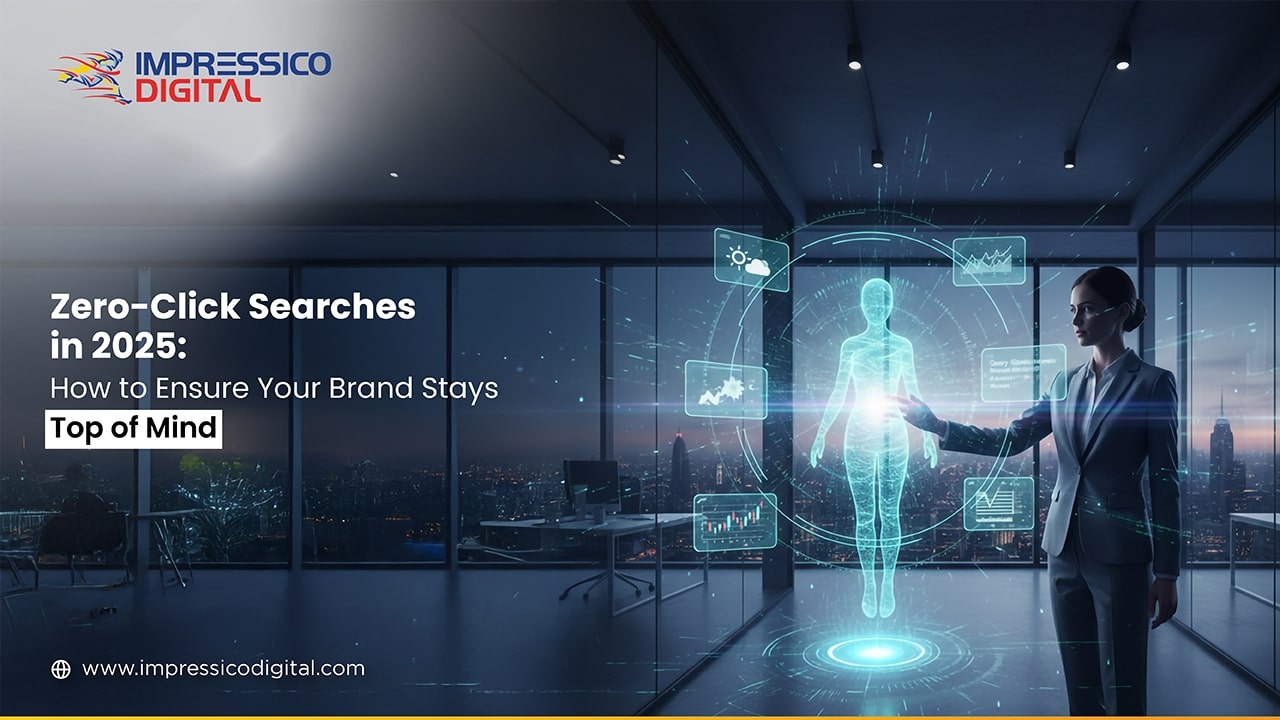In 2025, a major shift is unfolding in how people search online: more and more queries end without a click. In the U.S., for example, only about 40.3% of Google searches resulted in a click on an organic result in March 2025 — down from 44.2% a year earlier. That means roughly 27.2% of U.S. Google searches ended without a click in that same month.
This signals zero-click searches are no longer an edge phenomenon — they’re revolutionizing SEO, changing user behavior, and redefining how brands need to think about visibility. Those who are just relying on clicks are confronted with a new reality: answers appear within search results, frequently eliminating the need for clicks. To remain visible within this environment, it’s critical to comprehend zero-click searches, why they’re happening, their effect, and how to respond.
What Are Zero-Click Searches?
A zero-click search occurs when a user’s question is answered directly on the Search Engine Results Page (SERP) without the user needing to click through to a third-party website. The user may receive the answer through rich SERP features rather than via a standard link.
Some typical examples are:
- Featured Snippets — where there is a brief summary of the answer displayed at the top.
- Knowledge Panels — entity fact boxes that show up prominently.
- People Also Ask (PAA) boxes — click-to-expand questions with answers visible in SERP.
- AI Overviews — fresh summaries that condense information, frequently from more than one source, directly within search results.
These provide users with rapid responses, frequently obscuring click-through traffic previously generated by websites that offered this content.
Why Are Zero-Click Searches on the Rise in 2025?
A number of interconnected factors are fueling the zero-click movement in 2025:
AI Overviews and Generative Answers
Google’s AI Summaries are being shown more and more, particularly for question-based or problem-solving type queries. For instance, a study of 10,000 keywords noted AI Summaries pop up in almost 74% of problem-solving queries. (Search Engine Journal)
Mobile & Voice Search Growth
More queries are conducted on mobile and through voice assistants. These modes prefer short answers, summaries, or synthesized output over long pages, so rich SERP features and AI answers are more appealing. Users are experiencing impressions go up while clicks go down, particularly from mobile.
User Expectations for Instant Answers
With information abundant, users prefer instant satisfaction. If a direct answer is available without clicking, many accept that instead of digging for multiple sources. AI Overviews mentions how the urgency to rethink SEO strategies is driven by this change in user behavior.
Advanced SERP Features & Rich Snippets
Google and other search engines continue to roll out new mechanisms for delivering information on the SERP itself: knowledge panels, featured snippets, PAA, map packs, etc. These minimize clicks by satisfying informational requirements themselves. Indicates that zero-click is “the reality of modern-day search” where SERP does more of the “heavy lifting.”
Algorithmic and UI Changes
The structure of search results is changing. AI Overviews and featured snippets tend to command significant screen space, particularly on mobile. They move classical organic results down. As Google becomes more precise in what and when AI Overviews are displayed, their occurrence becomes more standard.
The Impact of Zero-Click Searches on SEO
Zero-click searches significantly influence the way brands think about SEO:
Decreased Click-Through Rates (CTR)
Even if you’re ranking high, if the answer is already visible through a snippet, knowledge panel, or AI Overview, there will be fewer users clicking through. Classic CTR benchmarks don’t apply neatly anymore.
Traffic Loss
Numerous sites have reported declines in organic traffic for queries now served up with direct answers. For some niches (news, information sites), the decline can be dramatic.
Shift in Visibility
Ranking #1 can still be great, but visibility isn’t just about ranking — it’s about being found in the answers and features that appear above and to the side of the fold.
More Competitive Content
Where SERP features are looking for high-authority content to display as summarized answers, websites with high expertise, content structured in a clear way, and trust signals are usually prioritized.
Changes in Keyword Value
Not all keywords are created equal in the zero-click world. Question-based queries and information or problem-solving keywords have a better chance of triggering AI Overviews or featured snippets than navigational (brand name) queries.
If you want to stay ahead of evolving search trends, consider exploring our SEO Services.
Zero-Click Searches vs. AI Overviews
Though they intersect, zero-click searches and AI Overviews are not identical.
| Definition | Any search where the user gets the needed info on SERP, no click to external site. | A Google-feature: a synthesized summary responding to user queries, often with citations to multiple sources. |
| Scope | Includes featured snippets, knowledge panels, PAAs, local packs, voice responses, etc. | More specifically; the summary box that appears at the top (or prominent area) of SERP. |
| User Behavior Effect | Reduces clicks on regular organic results. | Increases the presence of zero-click outcomes for certain questions/queries. |
| SEO Strategy Influence | Pushes brands to aim for visibility rather than just clicks. | Requires content that is structured and authoritative, to satisfy AI’s selection criteria. |
Generative AI SEO comes into play big time here. Brands need to optimize for being mentioned in AI Overviews, featured snippets, and more robust SERP features. Visibility from being part of an AI Overview is not always going to yield immediate traffic, but it does bear authority and visibility.
Opportunities Within Zero-Click Searches
Even though zero-click searches diminish click-throughs, they present new business potential:
Brand Authority & Credibility
Even a snippet or an AI Overview citation implies to users that your content is reliable. Being included in these features makes you a credible source.
Increased Awareness & Impressions
Since your content appears in additional SERP features, impressions increase even if clicks do not. That visibility can generate additional benefits: branded searches, social shares, and notices in follow-up queries.
First-Mover Advantages
Brands that innovate first can set the tone. If your content is already optimized for AI Overviews, featured snippets, knowledge panels, etc., you can have an advantage over competitors who do only traditional SEO.
New Traffic Sources
Even when organic SERP clicks decline, you might receive traffic from other sources: voice assistants, AI agents, featured snippets “sourced linkbacks,” or individuals clicking through from answer features. Additionally, more branded search occurs because individuals remember your brand as authoritative.
Improved User Experience
Clear, formatted, authoritative content generally works well for users. That often means improved dwell time, reduced bounce, social sharing, and other valuable metrics for search and visibility.
How to Keep Your Brand Visible
The following are actionable, tested strategies to keep (and increase) visibility in a zero-click world.
Optimize for Featured Snippets
- Find question-based keywords: “What is…”, “How to…”, “Why…”.
- Give brief, straightforward answers closer to the top of the page. Use list form or bullet points.
- Use headers (H2, H3) on those questions.
- Ensure your content is well-organized with definitions, examples.
Establish Topical Authority
- Tackle topics thoroughly. Rather than shallow articles, create sets of content built around central topics.
- Internal linking between topic sets makes it easier for search engines to interpret your expertise.
- Utilize up-to-date information, authoritative sources, and showcase expertise (case studies, expert quotes).
Use Schema Markup
- Structured data enables search engines to process content for rich features (FAQs, how-to, Q&A).
- Employ schema types relevant to your content, e.g., FAQ, HowTo, Article, LocalBusiness.
Optimize for “People Also Ask” (PAA)
- Track what questions are showing for your keywords.
- Create content that answers those questions directly (short paragraphs, concise subheads).
- Structure answers so PAA boxes can extract them.
Invest in Multi‐Format Content
- Video content can appear in video carousels or in SERP previews; voice search usually utilizes audio or summaries.
- Infographics, tables, or charts can draw featured snippets or visual panels.
- Podcast transcripts (optimized) can assist in long-form search.
Optimize for AI Overviews Specifically
- Employ authoritative sources, correct info. AI Overviews will favor high-authority content for inclusion.
- Utilize mid-volume and question-oriented keywords (these tend to trigger AI Overviews) instead of only pursuing extremely high volume keywords.
- Keep content fresh; update evergreen content every now and then so it remains topical for summaries.
UX & Mobile Friendly Design
- As zero-click and AI Overviews dominate mobile screens, make sure pages load quickly, are mobile-friendly, and content looks good on small screens.
- Utilize clean formatting: brief paragraphs, lists, bold important points.
Partner with us today and excel in Zero-Click Searches.
Metrics That Matter Beyond Clicks
To gauge success in this new world, we need to move our attention away from clicks in isolation. Here are the metrics that matter:
| Impressions | Shows how often your content appears in SERP features (snippets, overviews). More impressions = more visibility even without clicks. |
| Branded Search Lift | If people search for your brand by name more often, that signals awareness and trust. |
| AI Citations / Feature Inclusion | How often is your content being used in AI Overviews, snippets, knowledge panels? This is direct visibility. |
| PAA & Snippet Ranking | Track how many PAA boxes or featured snippet slots you win. |
| Engagement Metrics On-Site | If users come via snippet, maybe fewer clicks, but if they do, metrics like dwell time, bounce rate, and scroll depth matter more. |
| Voice Search & Assistant Use | Track traffic from voice search or AI/assistant platforms. It may come via other channels now. |
| Traffic Quality | Even with fewer clicks, are the clicks you do get from relevant searches converting? Or sharing / returning? |
Challenges & Risks of Relying on Zero-Click Visibility
There are opportunities, but there are also real dangers in over-relying on zero-click tactics:
Platform Dependency & Loss of Control
You rely on Google’s algorithm changes, UI design adjustments, or AI-feature introductions. When they adjust the way AI Overviews function, your ranking can drop suddenly.
Traffic Loss
Being referenced doesn’t necessarily translate to clicks. For most information-based queries, users might read the solution and leave. That translates into fewer sessions and fewer pageviews.
Decreased Monetization Opportunity
If fewer visit your site, ad income, affiliate revenue, or other in-site monetization could take a hit.
Limited Branding Visibility
In a featured snippet or AI Overview, your name might appear but not be viewed further. Lesser opportunity for users to engage thoroughly with your content.
Accuracy & Trust Problems
AI Overviews and featured snippets occasionally get it wrong or oversimplify. If your content is inaccurately represented in the summary, this can damage trust.
Changing User Expectations
Users may anticipate quick answers more often, with less tolerance for lengthy, in-depth articles. That’s a double-edged sword: helpful answers assist snippets but can discourage reading deep content.
The Future of Zero-Click Searches
The zero-click phenomenon is more than a flash in the pan — it’s shaping into a defining characteristic of search in 2025 and beyond.
- Visibility Over Clicks will take center stage. Search ranking remains critical, but appearing in AI Overviews, featured snippets, or knowledge panels might be more important than being clicked.
- Generative Engine Optimization (GEO) will become more powerful. Brands must create content with AI engines in mind: plain structure, authoritative signals, sources, and format. (GEO = optimizing for AI answer features and citations rather than legacy link-based SEO.)
- More Query Types Answered Directly: More queries will trigger AI summaries; question-based, how-to, and problem-solving queries will be answered more and more on the SERP instead of through external clicks.
- Legal, Ethical & UX Issues: With the rise in AI Overviews and zero-click functionality, concerns regarding attribution, ownership of content, accuracy, and bias will come into focus more strongly. Publishers are complaining in Europe and beyond about losing traffic and rights to their content.
- Adaptive SEO: SEO tactics will move away from being reactive (pursuing rankings) to being proactive (predicting what types of queries or features the AI or SERP will like). Ongoing monitoring, refreshing content, authoritativeness, structured data, and trust of users will be the top priority.
FAQ
What is a zero-click search in SEO?
A zero-click search is when a search query is answered directly on the search results page (SERP), such that the user does not click through to a website. This may be through featured snippets, AI Overviews, knowledge panels, or other rich SERP features.
Why are zero-click searches increasing in 2025?
They’re up due to user demand for immediate answers, mobile & voice search growth, AI Overviews / generative search improvements, and search engines’ desire to keep people on the SERP itself. And algorithm and UI shifts push traditional organic results below the fold.
How do zero-click searches affect website traffic and CTR?
CTR (click-through rate) is reduced when SERP answers questions directly. Even if you are high in rank, your click share can decrease. This causes traffic loss for pages that previously attracted visitors by providing those answers.
Are AI Overviews considered zero-click searches?
Yes. AI Overviews are one of the SERP features that tend to result in zero-click behavior. If an AI Overview answers a user’s question (and they don’t click on anything further), that is zero-click behavior.
What strategies improve visibility in zero-click searches?
Some top strategies:
- Optimize for featured snippets and question queries
- Apply structured data / schema markup
- Establish topical authority and robust, authoritative content
- Structure content well (lists, concise clear answers)
- Monitor and optimize for PAA and SERP features
- Adapt content for mobile, voice, and AI summarization
Can brands benefit from zero-click searches?
Absolutely. Being cited in a snippet or AI Overview bolsters credibility. Users see your brand name associated with answers, which helps recognition. Even without click traffic, this “visibility” has value in building trust, repeat visits, and branded searches.
Will zero-click searches replace traditional SEO?
Not entirely. Traditional SEO factors — keyword optimization, backlinks, quality content — are still important. The weighting is shifting: visibility in AI-powered features, rich snippets, and answer boxes is becoming as important (if not more so) than driving clicks from traditional organic listings. Brands require both solid traditional SEO and GEO-type optimizations.
Conclusion
The emergence of zero-click searches in 2025 is not something to fear if you evolve; it’s a strong indicator. Brands that maximize visibility — rather than traffic — will be at the forefront. GEO (Generative Engine Optimization) is becoming a necessity.
If you’re not sure if your brand is keeping pace, or you’d like professional assistance crafting an SEO + GEO strategy that gets your content cited, seen, and trusted — we at Impressico Digital are here to assist.
Contact us today, and let’s keep your brand in the spotlight regardless of how search changes.
Want to know more about us? Follow us on social media!



